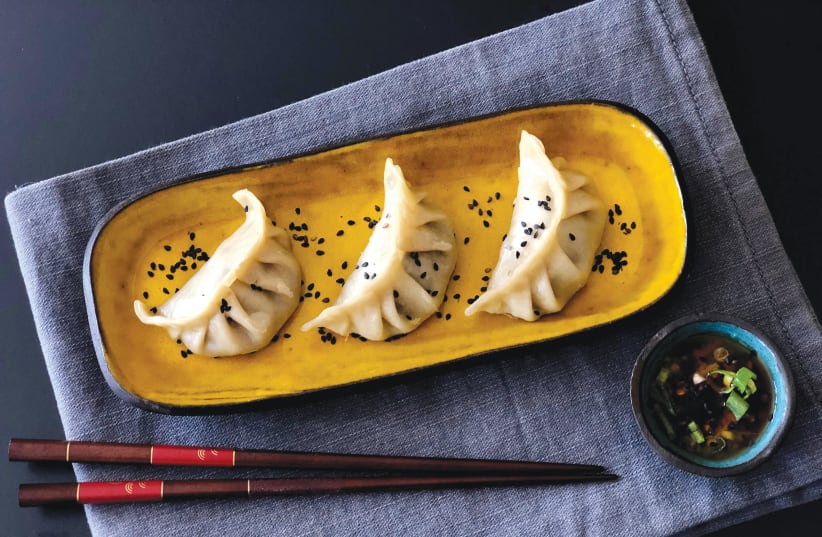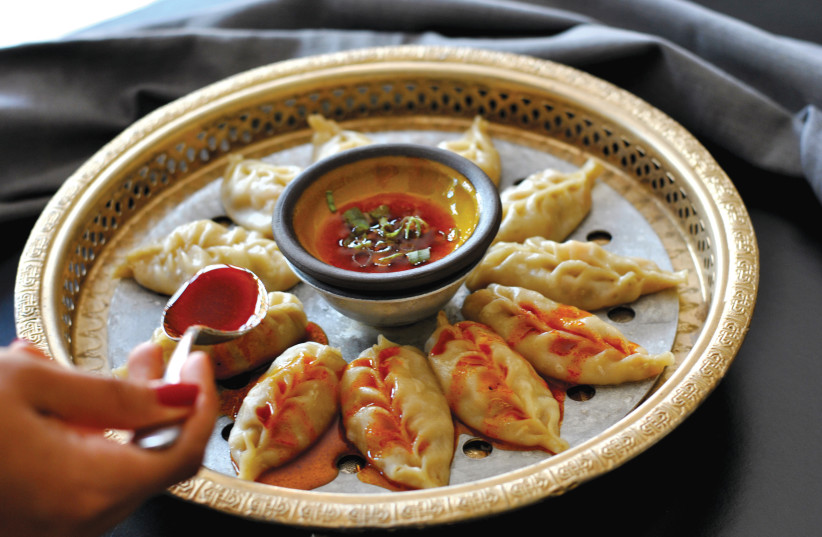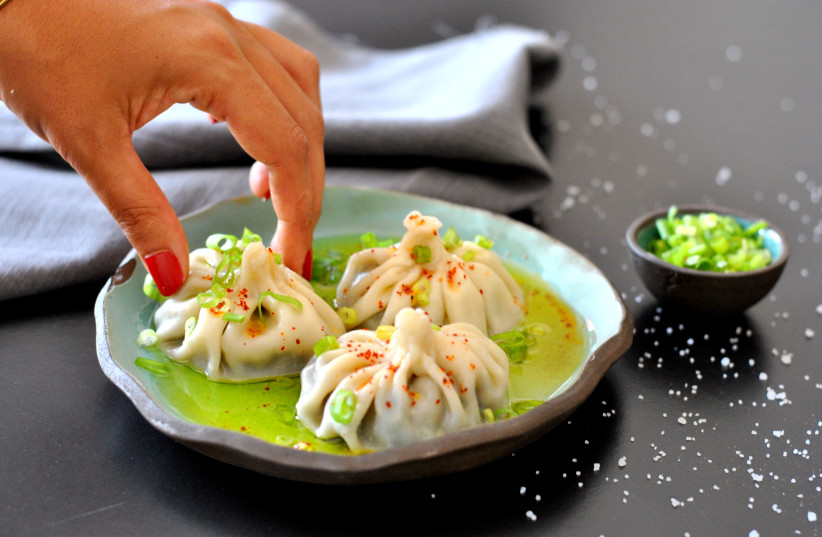The Tishrei holidays are a time of great excitement and renewal.
For the second year, we are celebrating the High Holy Days as the pandemic continues to make itself felt around the world. Many of us were used to joining family and loved ones at large gatherings and festive meals on Rosh Hashanah and Sukkot. This year, we are once again celebrating the festivals with a much smaller number of people sitting around the table.
One thing that we can do to make sure we feel the joy of the holidays is to prepare dishes that remind us of happier times. In preparation of the upcoming Sukkot holiday, in addition to preparing decorations to hang in the sukkah, we can also prepare tasty and healthy meals for our families.
It’s traditional on Sukkot to eat stuffed dishes, such as grape leaves, which remind us of the tribe of Judah’s vineyards, or stuffed cabbage, peppers or zucchini. Some people also make dumplings out of dough. In general, it is customary on Sukkot to eat hot dishes cooked in ceramic pots, since the fall evenings can sometimes be cool.
This year, I am presenting three recipes for vegetarian dumplings created by Mika Shimonov, who I soon learned is quite adept at preparing these delicacies. Mika and I spoke on the phone, I invited her over, and it wasn’t long before she showed up at my door with boxes full of ingredients.
“I grew up in Jerusalem in a traditional Bukharan family,” she says, “and my family’s roots can be found along the Silk Road. As a result, our cuisine includes a wide variety of ingredients hailing from both west and east.”
Mika admits that she found her way to the culinary arts by accident, having completed a bachelor’s degree in history and a master’s degree in education. Although she never took a cooking class, and learned everything she knows from trial and error, Mika says that her curiosity was piqued during her travels overseas, where she was introduced to new flavors. She learned how food could not be separated from its cultural and social components.
“Ever since then, food has become a significant part of my life,” she says. “The way we eat tells a story about our physical, emotional and spiritual selves.”
Upon her return to Israel, Mika began offering cooking workshops and vegetarian brunches at her home in Jaffa (details available at mikafoodart.com).
Up until the pandemic broke out, Mika would lead culinary tours to Georgia in which participants would learn about the local cuisine, including its flavors, spices and techniques.
During workshops she holds at home, Mika loves connecting with people as everyone learns about new cultures and flavors.
Dumplings are one of her favorite foods to prepare. “I love the mystery involved in not knowing what’s inside the dumpling until you bite into it. When I succeed in teaching someone how to make the precise folds required to make dumplings, my heart fills with happiness.”
VEGAN GYOZA JAPANESE DUMPLINGS
You can purchase prepared frozen gyoza dough in specialty stores that sell Asian products. You can use a bamboo steaming basket and line it with baking paper with holes in it. Alternatively, start out frying the dumplings and then steam them.
Makes 35-40 dumplings.
Dough: 500 gr. flour, siftedPinch of salt200–270 ml. boiling water
Filling:¼ small white cabbage, chopped finely2 carrots, grated4 garlic cloves, chopped2 Tbsp. ginger, ground¼ bunch of cilantro, chopped3 tsp. black sesame seeds1 handful of bean sprouts4 Tbsp. sugarPinch of salt6 Tbsp. soy sauce2 Tbsp. sesame oil
If frying:2-3 Tbsp. oil. Add more oil each time you begin frying another batch of dumplings.
If steaming: Water to cover 1/3 of the height of the dumplings.
Gyoza sauce: 4 Tbsp. soy sauce2 Tbsp. sweet chili pepper sauce1 Tbsp. spicy chili pepper sauceJuice from 1 lime
In a large bowl, mix the flour together with the salt. Gradually add the water while kneading the dough until thoroughly mixed. Cover and let it rest for an hour.
In a separate large bowl, mix all the filling ingredients and set aside.
Roll out the dough until it’s very thin, around 6-7 thickness on a pasta machine. Cut out 8-cm.-diameter circles and arrange them on the work surface. Place a spoonful of filling on each circle.
Pick up the dough on two opposite sides and begin pinching them together. Use a finger on your right hand to support the dough, and press it closed with a finger on your left hand. This way, you will end up with dumplings that look like accordions, with each one leaning on the piece next to it (see pictures).
Heat the oil in a pan and fry the dumplings for 3-4 minutes until they turn golden brown. Add water so that the bottom 1/3 of the dumplings is covered.
Cover the pan and cook over a high flame until all the water has evaporated. Uncover the pan and continue frying the bottom side of the dumplings.
Mix all of the sauce ingredients together in a separate bowl and serve alongside the dumplings.
Level of difficulty: Medium-hard.Time: 1.5 hours.Status: Parve.
PUMPKIN DUMPLINGS (MANTOU)
Mantou, in Bukharan cuisine, are vegetarian dumplings that are made from relatively dry dough that needs to be kneaded thoroughly.
Makes 23-30 pieces.
Dough: ½ kg. flour, sifted (continued)1 large egg120-180 ml. water1 tsp. salt
Filling: 400 gr. uncooked pumpkin, cut into small pieces2 large onions, chopped finely½ tsp. cuminSalt and pepper, to taste2 Tbsp. olive oil¼ tsp. caraway seeds
Sauce: ¼ tsp. black pepper¼ cup olive oil1 tsp. spicy paprika4 scallions, chopped finely
Place the flour in a large bowl. Add the egg and mix. Gradually add the water and salt while kneading. The dough should be hard and dry. (Flours have varying absorption rates. Just make sure the dough remains hard and dry.) Cover the dough and let it rest for 1 hour.
In a separate bowl, add all the filling ingredients and mix well. Taste and adjust seasoning.
You can roll out the dough using a rolling pin, but using a pasta machine will save time and effort. Cut the dough into a number of sections. Flatten each piece into a circle and then pass it through a pasta machine, from the thickest setting (1), and keep passing it through, each time increasing the number and making the pasta thinner, until you’ve passed the dough through on No. 5 or 6, depending on how thick you want the dough to be.
Place the rolled-out dough on the work surface and then take a 10-cm.-diameter glass and cut out dough circles. Place a spoonful of filling in the middle of each circle.
Pick up the dough on two opposite sides and begin pinching them together. Use a finger on your right hand to support the dough, and press it closed with a finger on your left hand. This way, you will end up with something that looks like a long braid. When you’re done, brush all of the mantou dumplings with oil (see pictures).
Fill a dumpling steamer basket ¾ full. Bring the water to a boil and arrange the dumplings in the second section of the steamer that has holes in it, and then place it on top of the boiling water. Cook for 30 minutes.
To prepare the sauce, mix all of the ingredients together and then pour over the hot dumplings. Serve hot.
Level of difficulty: Medium-hard.Time: 2 hours.Status: Parve.
MUSHROOM DUMPLINGS (HINIKALI)
This vegan recipe hails from Georgian cuisine. It, too, is made from hard, dry dough, and requires extensive kneading. It’s best to leave space between the dough and the filling, since the dough expands in the water.
Makes 25-30 dumplings.
Dough: 500 gr. flour, sifted1 tsp. salt1 cup water
Filling: 2 large onions, grated½ kg. mushrooms, champignon or portobello, grated coarsely¾ bunch of parsley, chopped finely1 spicy green pepper, choppedSalt and pepper, to taste
Sauce:¼ cup vinegar¼ cup olive oil¼ tsp. spicy paprika3 scallions or chives, chopped
Add the flour and salt to a large bowl and mix. Gradually add the water while kneading until the dough is mixed well and hard. Cover the bowl and let the dough rest for 1 hour.
To prepare the filling, add the onion and grated mushrooms to a large bowl. Add the parsley, green pepper, salt and pepper. Mix well.
Roll out the dough with a rolling pin or a dough roller at level 5 or 6 until it is thin.
Use a glass to cut out 10-cm.-diameter circles of dough. Place a spoonful of dough in the center of each dough circle.
Pick up the dough on two opposite sides and begin pinching them together. Use a finger on your right hand to support the dough, and press it closed with a finger on your left hand. This way, you will end up with something that looks like a pleated skirt (see pictures). Form a twirl with the dough at the top of each dumpling.
Fill a pot with water, add a teaspoon of salt and bring to a boil. Add the hinikali dumplings while stirring with a spoon until they are all floating. Do not stop stirring until they are all floating. Cook for 7 minutes, then remove with a slotted spoon and place on a serving dish.
To prepare the sauce, mix all of the ingredients together and then pour over the dumplings. Sprinkle pieces of spicy pepper on top.
Level of difficulty: Medium-hard.Time: 1.5 hours.Status: Parve.
TiPascale:
• The dough used to make dumplings should be pretty dry, so don’t add too much water. Add the water gradually and knead between additions until you reach the perfect texture.
• Roll out the dough to the desired thickness, depending on which filling you’ll be using. Use a thicker dough for beef fillings, since they will need to be steamed longer. For vegetarian dumplings, use a thinner dough, since they don’t need to steam as long.
• You can get the edge of the dumpling a little wet so that it’s easier to close up the sides and they won’t open up while they’re being steamed or fried.
• The dumplings should be steamed in an authentic bamboo steamer lined with baking paper with holes in it.
• You can make the mantou dumplings vegan by leaving out the egg.
• If you’re using an authentic steamer, you should either rub a little oil on the steamer, or on the dumplings themselves.
• If you’re making dumplings with a beef filling, take into consideration that the cooking time will be longer.
• Make sure not to overstuff the dumplings with filling, so that they won’t split open while they’re being steamed.
• Serve any sauce that you like with the dumplings. Add or change the sauce ingredients according to your taste.
Learn more about Pascale's Kitchen here>>
Translated by Hannah Hochner.



